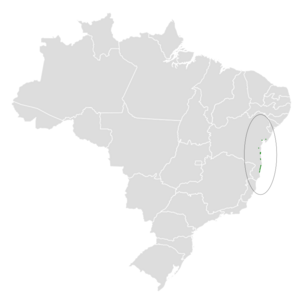Bahia antwren facts for kids
Quick facts for kids Bahia antwren |
|
|---|---|
| Conservation status | |
| Scientific classification | |
| Genus: |
Herpsilochmus
|
| Species: |
pileatus
|
 |
|
The Bahia antwren (Herpsilochmus pileatus), also called the pileated antwren, is a small bird found only in Brazil. It belongs to a group of birds known as "typical antbirds." This bird is currently considered a Near Threatened species, which means it could become endangered if its habitat continues to shrink.
Contents
Meet the Bahia Antwren
The Bahia antwren is a small bird, about 10.5 to 11 centimeters (4 to 4.3 inches) long. It weighs around 9 grams (0.3 ounces), which is about the same as two quarters!
What Does It Look Like?
Male Bahia antwrens have a black cap on their head and a black stripe through their eye. They have a white stripe above their eye. Their back is gray, with some black and white feathers. Their wings are black with white tips and edges. Their tail is black with white tips. The underside of their body is white with a gray tint.
Female Bahia antwrens look a bit different. They have a yellowish-brown forehead and a black and white striped cap. Their back is gray with a hint of olive green. Their underside is white with a yellowish-brown tint.
Where Do Bahia Antwrens Live?
The Bahia antwren lives only in the coastal areas of Bahia, Brazil. You can find them from south of Salvador down to the area of Trancoso.
Their Home: Restinga Woodlands
These birds prefer to live in restinga woodlands. These are special forests that grow on sandy soils near the coast. Bahia antwrens usually stay in the middle or top parts of the trees. They can be found from sea level up to about 840 meters (2,750 feet) high.
How Do Bahia Antwrens Behave?
Bahia antwrens are believed to live in the same area all year round. They do not migrate to other places.
What Do They Eat?
We don't know everything about what Bahia antwrens eat. But we do know they eat insects and probably spiders. They look for food alone, in pairs, or with their families. Sometimes, they join groups of different bird species to find food together.
They usually search for food about 5 meters (16 feet) above the ground, all the way up to the treetops. In bushy areas, they might feed lower down. They mostly pick insects off leaves, stems, vines, and branches. They often reach out or make short jumps from their perch to grab prey. Sometimes, they fly out briefly to catch an insect or hover to pick it off a plant.
What About Their Family Life?
Scientists do not know much about how Bahia antwrens raise their young. Their breeding habits are still a mystery!
What Sounds Do They Make?
The Bahia antwren's song is a fast series of very high, rising "toot" notes. It gets faster and ends in a rattling sound. The song lasts about two to three seconds. They also make calls, like a short "greep" note and a slower rattling sound.
Why Are Bahia Antwrens in Danger?
The IUCN (International Union for Conservation of Nature) first listed the Bahia antwren as "Vulnerable" in 2002. In 2023, its status was changed to "Near Threatened." This means it's still at risk, but maybe a little less so than before.
Threats to Their Home
There are not many Bahia antwrens left. Scientists estimate there are between 4,200 and 13,000 adult birds. Their numbers are believed to be going down. The coastal forests where they live in Bahia have become much smaller in recent years. This is because of logging companies cutting down trees and land being cleared for farms.
Even though they are common in the few places they live, and some live in protected areas, new problems are coming. Big plans to build beach resorts along the southern coast of Bahia could harm this bird's future.


